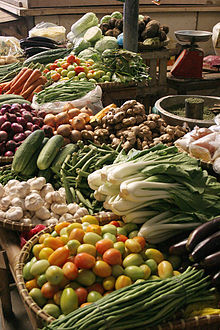World Health Organization[edit]
The World Health Organization (WHO) makes the following 5 recommendations with respect to both populations and individuals:[6]
- Maintain a healthy weight by eating roughly the same number of calories that your body is using.
- Limit intake of fats. Not more than 30% of the total calories should come from fats. Prefer unsaturated fats to saturated fats. Avoid trans fats.
- Eat at least 400 grams of fruits and vegetables per day (potatoes, sweet potatoes, cassava and other starchy roots do not count). A healthy diet also contains legumes (e.g. lentils, beans), whole grains and nuts.
- Limit the intake of simple sugars to less than 10% of calorie (below 5% of calories or 25 grams may be even better)[7]
- Limit salt / sodium from all sources and ensure that salt is iodized. Less than 5 grams of salt per day can reduce the risk of cardiovascular disease.[8]
Other WHO recommendations include ensuring that foods chosen have sufficient vitamins and certain minerals, avoiding directly poisonous (e.g. heavy metals) and carcinogenic (e.g. benzene) substances, avoiding foods contaminated by human pathogens (e.g. E. coli, tapeworm eggs), and replacing saturated fats with polyunsaturated fats in the diet can reduce the risk of coronary artery disease and diabetes.[8]
United States Department of Agriculture[edit]
The Dietary Guidelines for Americans by the United States Department of Agriculture (USDA) recommends three healthy patterns of diet, summarized in table below, for a 2000 kcal diet.[9]
It emphasizes both health and environmental sustainability and a flexible approach: the committee that drafted it wrote: "The major findings regarding sustainable diets were that a diet higher in plant-based foods, such as vegetables, fruits, whole grains, legumes, nuts, and seeds, and lower in calories and animal-based foods is more health promoting and is associated with less environmental impact than is the current U.S. diet. This pattern of eating can be achieved through a variety of dietary patterns, including the “Healthy U.S.-style Pattern,” the “Healthy Vegetarian Pattern," and the "Healthy Mediterranean-style Pattern".[10] Food group amounts are per day, unless noted per week.
| Food group/subgroup (units) | Healthy U.S. patterns | Healthy Vegetarian patterns | Healthy Med-style patterns |
|---|---|---|---|
| Fruits (cup eq) | 2 | 2 | 2.5 |
| Vegetables (cup eq) | 2.5 | 2.5 | 2.5 |
| Dark green | 1.5/wk | 1.5/wk | 1.5/wk |
| Red/orange | 5.5/wk | 5.5/wk | 5.5/wk |
| Starchy | 5/wk | 5/wk | 5/wk |
| Legumes | 1.5/wk | 3/wk | 1.5/wk |
| Others | 4/wk | 4/wk | 4/wk |
| Grains (oz eq) | 6 | 6.5 | 6 |
| Whole | 3 | 3.5 | 3 |
| Refined | 3 | 3 | 3 |
| Dairy (cup eq) | 3 | 3 | 2 |
| Protein Foods (oz eq) | 5.5 | 3.5 | 6.5 |
| Meat (red and processed) | 12.5/wk | -- | 12.5/wk |
| Poultry | 10.5/wk | -- | 10.5/wk |
| Seafood | 8/wk | -- |
